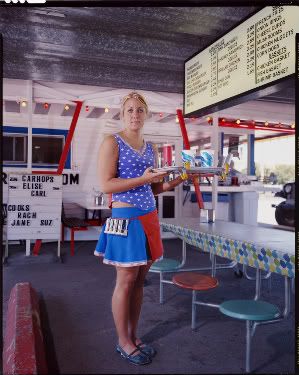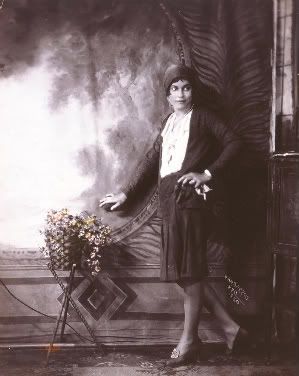A portrait is an image of a person

J. Shimon & J. Lindemann, Elise at Work, Manitowoc, Wisconsin, 2007. Inkjet pigment print from 8 x 10 transparency, 20 x 16 in. Ed. 2/10
What is wrapped up in a portrait? We see so many each day that we never really stop to think about what the creation of a person’s image encompasses and implies. When you make a portrait, whether it’s a marble bust, a painting, a professional photograph, or a snapshot of a friend, you are capturing the essence of a real, live person: someone that lives and breathes, that works and feels and exists in the world. A portrait is an image of a person.
Unmasked & Anonymous: Shimon and Lindemann Consider Portraiture brings this most basic and oft-forgotten aspect of portraiture to the forefront of our consciousness. A portrait is an image of a person. Through works of their own and carefully culled works from the Milwaukee Art Museum’s collection of photographs and daguerreotypes, John Shimon and Julie Lindemann (with help from hotshot MAM curator Lisa Hostettler) bring us face to face with all of the ambiguities and inherent contradictions of taking a portrait, an image of a person.
While there are many threads of meaning to pluck at, perhaps the central theme is in the exhibition’s title. A portrait is an image, and an image is also the conscious projection of a person. An image is a mask we put on to make ourselves anonymous, to prevent others from knowing us. When faced with a camera, either consciously or unconsciously, we put on a face, a mask, that we think hides us. We smile big, or we glower threateningly, or we smirk, or purse our lips. We stand up straighter, or perhaps slump deeper into a hunch. Regardless of the image we are attempting to project, we are projecting an image, and it is this image the camera captures.

James Van Der Zee, Distraction, 1930. Hand-colored gelatin silver print, 9 9/16 x 7 9/16 in. Milwaukee Art Museum Purchase, African American Art Acquisition Fund, Photography by John R. Glembin
And yet this mask often reveals as much as it conceals. In “The Hanson Brothers,” for instance, one sibling is slightly in front of the other, and both stare directly into the camera, serious expressions that show how seriously they take this business of sitting for a portrait. This seriousness, their gravitas, is affected, though. It is belied by the playful Hawaiian shirt and Captain Hook mustache of one brother, and by the ironic tilt of an eyebrow and the hint of a smirk at the corner of the other’s mouth.
Some of the posturing we do in portraiture is unconscious. We become accustomed to having our likeness taken at young ages, inured to the process by the ritual of school pictures. We learn head up, chin down, eyes on the camera but face tilted slightly away from it. We learn sitting up straight and the acceptable ways to cross our arms and hands and legs. “Caitlin in a Rose Dress” displays the depths to which we can absorb these unwritten rules of portraiture. Her posture and gaze mimic those of the anonymous figures in the daguerreotypes of the Museum’s collection so precisely that it is only the presence of her decolletage that marks her as a denizen of today’s time and place and not the foggy lost ages of long ago.
These portraits are slices of time, one-shot glimpses into specific times and places in people’s lives. Shimon and Lindemann explore this theme through multiple portraits of the same people from their circle in Manitowoc over the course of several years. The changes, and the lack of change, over the length of their relationship with the photographers is documented. We see the slices of time that are individual portraits, the captured moments, but we also see the progression of those moments.
Perhaps the most fascinating and most obscure aspect of Shimon and Lindemann’s work is this relationship they have developed with their subjects. The old daguerreotypes and tintypes of the past and the one-time shots of modern and contemporary portraits are presented in contrast to the works of Shimon and Lindemann. These photographers have spent half a lifetime, almost two decades, living and working in the same moderate-sized town in Wisconsin. They have developed real relationships, real and enduring friendships, with the people they work with. They have seen and documented important events in the lives of these people, and also the mundane of their every day lives. Shimon and Lindemann have blended the different forms of portraiture: the commercial, the artistic and the snapshot.
Unmasked & Anonymous is a reflection on our society’s relationship with the camera, and the personal relationship of two photographers with their subjects. It explores the many forms of identity that we can create, and the ways and means we use to create them. And it shows that we are not as good at constructing masks as we might like to think ourselves. VS





















